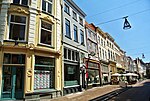Vechte

The Vechte (German pronunciation: [ˈfɛçtə]) (in German and in Low Saxon (Dutch Low Saxon pronunciation: [v̯ɛxtə]) or Vecht (in Dutch) (Dutch pronunciation: [vɛxt]), often called Overijsselse Vecht (Dutch pronunciation: [oːvərˈɛi̯səlsə ˈvɛxt]) in the Netherlands to avoid confusion with its Utrecht counterpart, is a river in Germany and the Netherlands. Its total length is 182 km (113 mi), of which 107 km (66 mi) are on German soil. The Vechte originates in Oberdarfeld in the German state of North Rhine-Westphalia near the city of Coesfeld and flows north into the state of Lower Saxony, past the towns of Nordhorn and Emlichheim, across the border and then westwards into the Dutch province of Overijssel (hence its alternate Dutch designation). There, it flows through the north part of the Salland region past Hardenberg and Ommen, taking in the water of the Regge stream along the way. Close to the city of Zwolle, the river suddenly bends north to end in confluence with the Zwarte Water river near the town of Hasselt. The Vechte is probably the Vidrus mentioned by Ptolemy in his map of Magna Germania.
Excerpt from the Wikipedia article Vechte (License: CC BY-SA 3.0, Authors, Images).Vechte
Zwolsedijk, Zwartewaterland
Geographical coordinates (GPS) Address Nearby Places Show on map
Geographical coordinates (GPS)
| Latitude | Longitude |
|---|---|
| N 52.562222222222 ° | E 6.1011111111111 ° |
Address
Zwolsedijk
Zwolsedijk
8061 RD Zwartewaterland
Overijssel, Netherlands
Open on Google Maps








